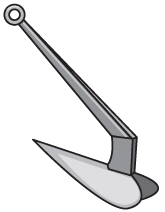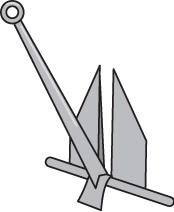Anchoring - Part 1
Though anchors are not required by federal law, many states have anchor requirements. It is advisable to carry an anchor for both recreational and emergency use.
Anchors Should Have:
Line, chain (called "rode"), and anchor (all items together are called "ground tackle"). The chain helps you to set and retrieve the anchor. The amount of rode (line + chain) to have out depends on the water depth in which you plan to set anchor. As a general rule of thumb, your rode should be 7 to 10 times the depth of the water in which you will anchor. You will need more rode in bad weather or rough water. Anchors can be of assistance in emergency situations—especially in case of engine failure in rough waters or currents. As such, make sure the anchor is always accessible and the rode is free of entanglements.
TYPES OF ANCHORS: There are a number of anchor types. The most common recreational anchors are listed below. Choose the anchor type that meets yoru requirements.

Plow
Lands sideways: buries when pulled. Best for rocky bottoms, weeds, and grass.

Danforth
Pivoting flukes bury the anchor. Best for soft mud and grass.

Mushroom
For canoes and inflatables. Best for flat bottoms.
32/33